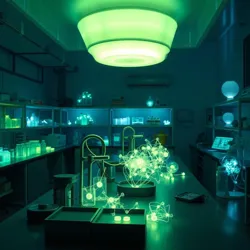Autonomous Bioluminescent Systems
Autonomous Bioluminescent Systems (ABS) are advanced technological constructs that integrate biological and synthetic components to produce and control light independently. These systems are utilized in various fields, including environmental monitoring, medical diagnostics, and entertainment.

An example of bioluminescent organisms used in research settings.
Overview
Autonomous Bioluminescent Systems are designed to mimic the natural light-emitting properties of organisms such as certain bacteria, algae, and jellyfish. By harnessing the biochemical processes of bioluminescence and integrating them with modern technology, ABS can provide sustainable and efficient lighting solutions.
Key Components
- Bioluminescent Organisms: The core of these systems relies on organisms engineered to produce light through biochemical reactions involving luciferase enzymes and luciferin substrates.
- Synthetic Enhancements: Advanced materials and electronics are used to control and amplify the light output, providing greater flexibility and functionality.
- Autonomous Control: Embedded systems and algorithms allow for the automatic regulation of light intensity and timing, adapting to environmental changes or user inputs.
Applications
Autonomous Bioluminescent Systems have versatile applications across several domains:
Environmental Monitoring
ABS are employed in ecological studies for monitoring and tracking wildlife, particularly in marine environments. The systems can be used to illuminate specific areas, aiding in the observation of nocturnal behaviors and underwater ecosystems.
Medical Diagnostics
In medicine, bioluminescent markers are used in diagnostic imaging and research. ABS can enhance these applications by providing controlled and sustained light emissions, improving the accuracy and efficiency of medical tests.
Entertainment and Art
The aesthetic appeal of bioluminescence has led to its integration into artistic installations and entertainment venues. Autonomous Bioluminescent Systems can create dynamic light displays, offering a unique and eco-friendly alternative to traditional lighting.
Development and Innovations
The development of ABS has been propelled by breakthroughs in Silico-Biological Fusion and Neural Interface Engineering, enabling more sophisticated control of bioluminescent properties.
- Bioluminescent Circuitry: Innovation in this area has led to the creation of circuits that can enhance and manipulate natural light production for various uses.
- Neural Control Systems: Interfaces that allow for real-time adjustment of the bioluminescent output based on neural signals have been developed, expanding the potential applications of these systems.
Ethical and Environmental Considerations
While Autonomous Bioluminescent Systems offer numerous benefits, they also raise ethical and environmental concerns. The manipulation of living organisms and the potential ecological impacts of introducing synthetic bioluminescent elements into natural habitats are subjects of ongoing debate. Advocates for responsible innovation stress the importance of conducting thorough impact assessments and ensuring sustainable practices.
Future Prospects
Research into Autonomous Bioluminescent Systems is ongoing, with future directions focusing on enhancing energy efficiency, expanding the range of light colors produced, and improving the integration of these systems into everyday applications. The potential to combine bioluminescence with cognitive augmentation technologies is also being explored, promising new frontiers in both functional and aesthetic uses.
See Also
- Silico-Biological Fusion
- Bioluminescent Circuitry
- Neural Interface Engineering
- Cognitive Augmentation
Autonomous Bioluminescent Systems represent a fascinating intersection of biology and technology, offering sustainable solutions and inspiring innovations across multiple fields. As research and development continue, these systems are poised to play a significant role in the future of both functional and decorative lighting.